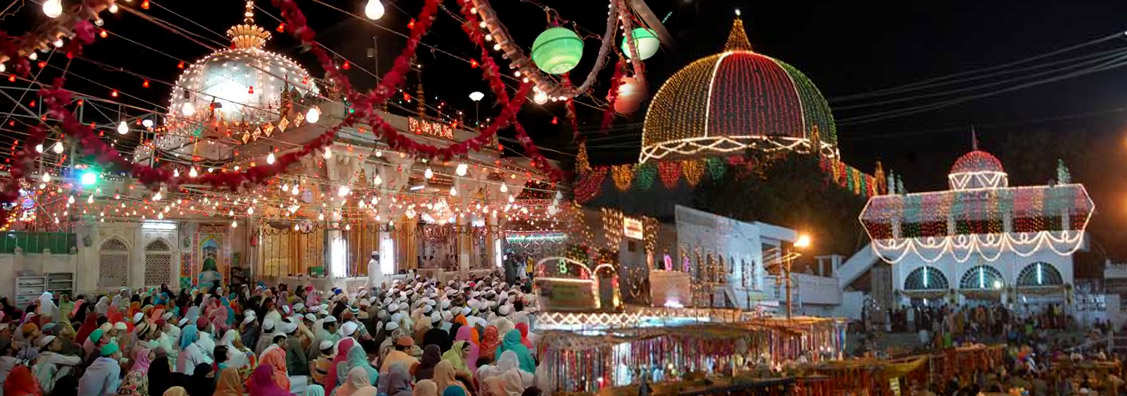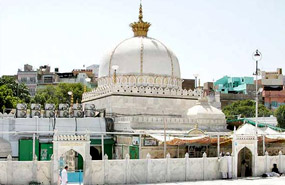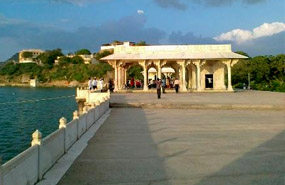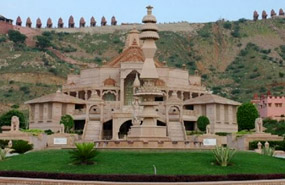

Home / Attractions / Ajmer
Ajmer is one of the major and oldest cities in the Indian state of Rajasthan and the centre of the eponymous Ajmer District. It is located at the centre of Rajasthan.
The city was established as "Ajayameru" by a Shakambhari Chahamana (Chauhan) ruler, either Ajayaraja I or Ajayaraja II, and served as the Chahamana capital until the 12th century CE.
Ajmer has been selected as one of the heritage cities for the HRIDAY - Heritage City Development and Augmentation Yojana [6] and Smart City Mission schemes of Government of India. It's population was counted 0.25 million in year 2011.
At the time of Independence Ajmer Continued as a separate state with its own legislature until its merger with erstwhile Rajputana province then called Rajasthan.The Legislature of Ajmer State was housed in the building which now houses T.T. College .It had 30 MLAs. and Haribhau Upadhaya was the first Chief Minister of the erstwhile state and Bhagirath Chaudhary as the first Vidhan Sabha Speaker.In 1956, After acceptance of the proposal by Fazil Ali , Ajmer was merged into Rajasthan to form Ajmer District with addition of Kishangarh sub-division of Jaipur district.
During Colonial times Ajmer city served as the headquarters of Ajmer - Merwara Province and possessed a Central jail, a large General Hospital, and two smaller hospitals according to Gazetteer, 1908 .It was the head-quarters of a native regiment and of a Railway Volunteer corps.From 1900s ,The United Free Church of Scotland, the church of England, the Roman Catholics, and the American Episcopal Methodists have mission establishments here.[13] At that time there were twelve printing presses in the city, from which eight weekly newspapers were published.
Ajmer is surrounded by the Aravalli Mountains. It is the base for visiting Pushkar (11 km), an ancient Hindu pilgrimage city, famous for the temple of Lord Brahma. Ajmer had been a municipality since 1869.
Ajmer was originally known as Ajayameru. The 12th century text Prithviraja Vijaya states that the Shakambhari Chahamana (Chauhan) king Ajayaraja II (ruled c. 1110 – 1135 CE) established the city of Ajayameru. Historian Dasharatha Sharma notes that the earliest mention of the city's name occurs in Palha's Pattavali, which was copied in 1113 CE (1170 VS) at Dhara. This suggests that Ajmer was founded sometime before 1113 CE.[ A prashasti (eulogistic inscription), issued by Vigraharaja IV and found at Adhai Din Ka Jhonpra, states Ajayadeva (that is, Ajayaraja II) moved his residence to Ajmer.
The later text Prabandha-Kosha states that it was the 8th century king Ajayaraja I who commissioned the Ajayameru fort, which later came to be known as the Taragarh fort of Ajmer. According to historian R. B. Singh, this claim appears to be true, as inscriptions dated to the 8th century CE have been found at Ajmer. Singh theorizes that Ajayaraja II later expanded the town area, constructed palaces, and moved the Chahamana capital from Shakambhari to Ajmer.
Mughal prince Dara Shikoh was born here in 1615. Jahanara Begum powerful mughal princess also born here.
There are several sightseeing places in Ajmer in which Hazrat Khwaja Garib Nawaz (Ajmer Sharif), Anna Saga Lake and Nareli Jain Templer are to be described below-

Ajmer Sharif Dargah, the tomb of Moinuddin Chishti is one of the holiest places of worship in India not only for the Muslims but followers of every faith. It is believed that a person who prays with a pure heart at the Ajmer Sharif Dargah, gets all his or her wishes fulfilled. Ajmer Sharif is a Sufi shrine and one of the most visited places in Ajmer. The pious Persian Sufi saint, Khwaja Moinuddin Chishti who is well-known for its secular preaching is enshrined here. Many Muslims believe that Moinuddin Chisti was Muhammad's direct descendant and it was on his request (Muhammad came to his dream) he went to India. He reached Ajmer in 1192 via Lahore and stayed there till his death in 1236 AD.
His shrine was built by Mughal Emperor Humayun, and in order to enter the dargah, you need to go through a series of massive doors made from silver with beautiful carvings. As you reach the courtyard, you would come across the tomb of Moinuddin Chishti, carved out of marble. It has gold plating on top and is guarded by a railing made from silver and a marble screen.
There are several mosques inside the dargah complex, built by Akbar and Shah Jahan, who made it a point to visit Ajmer at least once a year.
Dargah Sharif is undoubtedly the most famous pilgrimage centre in Rajasthan. It is the resting place of Khwaja Moin-ud-din Chisti, who was a great Sufi Saint and dedicated his entire life for the upliftment of the poor and downtrodden. The shrine is visited by millions of people every year, as it is considered very sacred by people of all the religions. Ajmer Sharif was built by the Mughals, hence justifying the rich Mughal Architecture. The Dargah has various constituents like tombs, courtyards and Daalaans. The major among these structures are- Nizam Gate, Buland Darwaza, Jama Masjid, Aulia Masjid, Dargah Shrine, Mehfilkhana and about a dozen of other prominent establishments.
One can spot two huge cauldrons in the inner courtyard of the shrine. These containers have a capacity of 2240 kg and 4480 kg and are used during special occasions to cook sweet delicacies like Kheer. The material used in building the main tomb of Ajmer Sharif Dargah is mostly marble and gold plating, which is guarded by silver railings and a marble screen. Visitors are welcomed by a relaxing aura at the Dargah, which is brought in by the combined effect of flowers, incense sticks and the spiritual vibes.
The place is an architectural marvel and perfect for connecting to your spiritual self. You do not have to be religious in order to visit this place. The peacefulness and serenity of this place is something that you would not get anywhere else.

The breathtaking and gorgeous Ana Sagar Lake is a magnificent artificial lake that is located in the city of Ajmer in Rajasthan, India. This lake, which dries up every year in the summer season, is best visited during the sunsets when the views are extraordinarily marvellous to look at. The sight of the lake from the nearby temple is also particularly enchanting. Do not forget to take a camera to capture the fantastic and heavenly views that you behold here. All in all, a visit to the Ana Sagar Lake is a must when you are in Ajmer, for the beauty of this lake can be enjoyed and cherished with friends and family alike. Today, the Ana Sagar Lake is one of Ajmer's most popular lakes and is also one of the largest lakes that India is home to.
The construction of this critical site took place under the purview and instructions of Anaji Tomar, who was the grandfather of the grand and majestic king Prithvi Raj Chauhan. In fact, the lake is named after the king Anaji himself. The lake was founded during the 12th century after a dam was built across the Luni River, as a means to promote a better lifestyle amongst the people. Today, the Ana Sagar Lake is one of Ajmer's most popular lakes and is also one of the largest lakes that India is home to.
The Ana Sagar Lake is surrounded by Daulat Bagh Gardens, which is a splendid garden full of vast open spaces and lush greenery, and the Khobra Behroon temple- two popular attractions of Ajmer that tourists prefer to visit along with a day trip to the beautiful lake. The lake is only 13 kilometres away from the main city of Ajmer. An island can be spotted in the centre of the lake. Tourists love to indulge in boating or water scooter rides here. The lake is about 4.4 metres deep and spreads over an area of 12 kilometres.

At a distance of 9 km from Ajmer Junction Railway Station, Nareli Jain Temple is a new Jain temple situated on NH-8 in the outskirts of Ajmer in Rajasthan. This is an important point of pilgrimage for Digambara Jains and also one of the top Ajmer attractions.
Nareli Jain Temple, also known as Sri Gyanodaya Tirth Kshetra, is a modern edifice built by Ashok Patni of RK Marbles. Acharya Sri Vidya Sagar's disciple Jain Sage, Muni Sudha Sagar blessed the construction of the temple and the building work started on 1994-95. In the year 2002 the largest ever-made statues of Ashta-dhatu are being installed at the temple complex. The temple was estimated to cost around Rupees 50 crore, but ended up costing close to Rupees 100 crore. The temple grounds of Nareli Jain Temple are based over the entire hilly region and innumerable devotees throng the temple, particularly the Jain communities, who belong to Digambara sects.
The temple is slightly angular in shape and boasts of contemporary architectural pattern. The Nareli Jain Temple complex consists of 24 temples, each dedicated to the 24 Jain Tirthankaras. Out of 24 images of the Jain Tirthankaras, the images of the three Tirthankaras named as Arahnath, Kunthunath and Sri Shantinath have been established at the temple. Each of the Tirthankara idols weight about 24 tons. The temple is well known for its carvings and intricate designs.
It is getting popular amongst the tourist for its beautiful architecture and intricate stone carvings which gives both traditional and contemporary look. The temple is made of marble stone and is known for fulfilling wishes and bringing prosperity in life. The main temple has a huge idol of Guru Adinath Ji on the 1st floor with 24 miniature temples of other Tirthankar's line up on the hills above. The view from the top is spectacular and breathtaking.
